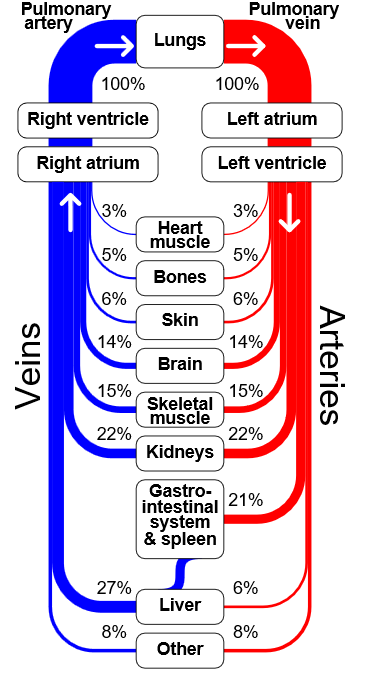How can Yoga Therapy help in keeping the heart healthy?
- It is important to understand that the heart is the centre and a critical component of the circulatory system. In fact, it’s only function is to pump blood to various parts of the body.
- The blood is the next critical component. It is a body fluid, comprising approximately 7% body weight and 5 litres by volume. Also, it comprises of erythrocytes or red blood cells, leukocytes or white blood cells, thrombocytes or platlets, electrolytes and nutrients suspended in blood plasma. In fact, these active components are transported to various parts of the body for conversion into usable outcomes, called metabolism.
- Additionally, the lymphatic system, supported by blood, regulates heat in the body and ensures critical safety functions such as directing blood to various organs in the body.
- Finally, the blood brings back metabolic waste matter such as –HCO3, urea, uric acid etc. for disposal, thus maintaining the health of the body.

Heart – circulation system.
How does the heart work?
The heart is a pump which is situated in the middle compartment of the chest and performs 2 functions;
- First, it pumps deoxygenated blood to the lungs for re-oxygenation. This is called pulmonary circulation. Deoxygenated blood from various parts of the body is received in the right atria through the superior and inferior venae cavae – 2 major veins. Next, the blood flows into the right ventricle and is pumped to the lungs through the pulmonary artery where carbon dioxide and water vapour are exchanged for oxygen.
- The freshly oxygenated blood received from the lungs is pumped to the various parts of the body. This is called systemic circulation. The blood, rich in oxygen, is received from the lungs at the left atria through the pulmonary veins. This oxygen rich blood flows into the left ventricle and is pumped to the rest of the body through the aorta which distributes oxygenated blood throughout the body.
So, the heart functions as the centre of a closed loop system where blood is circulated to and from various parts of the body.
What are some factors that drive the physiology of the heart?
The functioning of the heart is measure using the following parameters;
-
- Blood pressure – Blood pressure is the pressure exerted by the blood on the walls of the various blood vessels. Blood pressure is usually expressed as a ratio between systole (the maximum pressure exerted by the heart) and diastole (the minimum pressure between 2 systoles). It is measured in millimetres of mercury, with atmospheric pressure assumed to be 0, also called gauge pressure. In a normal person, the blood pressure or resting pressure should range between 90 – 120 for systolic pressure and 60 – 80 for diastolic pressure. When this pressure increases, the condition is called hypertension or high blood pressure and when is below the range, it is called hypotension or low blood pressure.
- Heart rate – The heart rate is the measure of the number of contractions of the heart per minute. It is generally close to the pulse rate and the accepted resting rate is considered to be between 50-90.
- Pulse – Pulse is the measure of palpitation of the heart when measured by pressing the artery against a bone, such as at the wrist, groin, ankle joint etc. Generally, for an adult, this should be between 60 – 100 pulses per minute.
- Blood volume – Humans have approximately 5 litres of blood circulating in the body. It is generally more in males than females. This volume is regulated by the kidneys and is generally impacted by age and obesity.
What are some of the issues of the circulatory system?
The heart cannot be taken in isolation, it has to be viewed as a part of the circulatory system. In fact, blood is the only fluid which reaches every part of the body carrying oxygen and nutrients for proper functioning of the various systems of the body.
So, the following issues could arise which impair proper flow of blood and functioning of the heart;
-
- Heart ailments – the heart itself could enlarge or suffer from defective parts such as valves, blood vessels etc.
- Blockages – if there is resistance to the flow of blood in the arteries, the heart has to work harder to pump blood to the various parts of the body.
- Blood vessel condition – blood vessels could lose their elasticity and become weak. This results in various illnesses, including aneurism and thrombosis.
- Stress – Stress has a major impact on the health of the circulatory system. In any stress situation, adrenaline and cortisol are pumped into the circulatory system to allow the person to cope with the situation. This redirects blood from its normal course to the various organs in preparation of fight or flight. However, when the stressor is removed, the body takes awhile to return to its original position, until all the adrenaline and cortisol have been purged from the system. Failure to manage stress can lead to many circulatory system illnesses.
- Lungs – one of the major activities of the heart is pulmonary respiration. If the lungs do not exchange CO2 & water for oxygen, then there is a major impact on metabolism. Consequently, the heart, which receives 3% of total blood supply gets affected also.
What do we need to control in order to have a healthy heart?
Solution to any circulatory illness depends a lot on lifestyle, age and hereditary issues. The solutions are not necessarily in order of priority, but some or all may apply to the practitioner;
- Lipids – This are issues related to formation of deposits on the walls of the arteries. This results in the arteries losing their elasticity to pulse and the deposits narrow the blood vessels requiring the heart to pump harder to reach various parts of the body. This generally comes from improper diet and lack of exercise and is reasonably easy to fix. Proper diet and asana can provide a solution, for people of all ages.
- Stress – it is possible for stress to increase blood pressure to a point where it affects critical organs such as the kidneys (which receives 22% of all blood supply), brain (which receives 14% of all supplies) or the digestive system (which receive 27% of all supply). Here, diet will play an important part in maintaining circulatory system condition, but asana, pranayama and meditation will play a key role in reducing stress, counteracting the effects of prolonged exposure to adrenaline and cortisol.
- Chronic degenerative disease – if an organ has not suffered catastrophic failure, asana, pranayama and meditation can perform a maintenance action to prolong cellular respiration and reconstruction.
- Catastrophic degenerative disease – In this case surgery or medical intervention may be necessary. In such a case, asana, pranayama and meditation will assist in recovery and long term post operative recovery.
- Blood vessels elasticity – When the veins and arteries lose their elasticity, asana can help in directing blood flow to the affected area. While complete recovery may not be possible, asana can assist in increasing strength in the affected area.
What are some of the āsana solutions for a healthy heart?
Solution to heart ailments depends a lot on lifestyle, and age;
- Āsana cannot replace medication; they can help in restoration and recovery. They cannot be used as an independent tool for therapy.
- Āsana and prāṇāyāma are an excellent tool to build resistance such that over time, a near normalcy state is reached.
- Diet is critical for success of yoga for therapy. Being in the weight range for one’s specified height ensures drop in fat content and greater flexibility in performance of āsana. In fact, correct weight also ensures greater capillary action and cellular respiration.
- The āsana plan will start with simple āsanas which do not stress the heart, and prāṇāyāma to stabilise nasal pressure. Subsequently, more complex āsanas can be added.
Schoolof yoga explains – the āsana plan
The āsana plan given below is indicative. The practitioner should tailor the plan to ones age, health and lifestyle in consultation with a qualified doctor.
- Starters – 3 months – all āsanas to be performed slowly under supervision of a doctor.
- Intermediate – 3 months – all āsanas to be performed only after improvement is detected and after OK from doctor. Estimated time – 30 mins.
- Final – all āsanas to be performed only after substantial improvement is detected and after OK from doctor. Estimated time – 45 mins.
|
Āsana |
Beginner | Intermediate |
Final |
|
| SN | 3 months | 3 months | thereafter | |
| 1 | Padmāsana | 3 mins | 3 mins | 3 mins |
| 2 | Tadāsana | 2 | 2 | 2 |
| 3 | Trikonāsana | – | 1 | 2 |
| 4 | Pādahastāsana | – | 1 | 2 |
| 5 | Veerabadrāsana | – | 1 | 2 |
| 6 | Bhujaṃgāsana | 1 | 2 | 3 |
| 7 | Śalabhāsana | – | 1 | 3 |
| 8 | Dhanurāsana | – | 1 | 3 |
| 9 | Pavanamuktāsana | 1 (one leg) | 2 (normal) | 3 (normal) |
| 10 | Arda-halāsana | 1 (one leg) | 2 (normal) | 3 (normal) |
| 11 | Sundara viparīta-karaṇī | 3 mins x 2 | 5 mins x 2 | 15 mins |
| 12 | Sethubandāsana | 1 x 10 counts | 1 x 20 counts | 1 x 50 counts |
| 13 | Nāḍī-śuddhi prāṇāyāma (No kumbaka) | 5 x 1 cycles | 5 x 2 cycles | 10 x 2 cycles |
| 14 | Bhramarī prāṇāyāma | 2 cycles | 5 cycles | 5 cycles |
| 15 | Ujjeyi prāṇāyāma | 2 cycles | 5 cycles | 5 cycles |
| 16 | Shavāsana | 5 mins | 5 mins | 5 mins |
| 17 | Meditation – dhyāna (sit in silence and focus on the breath) | 10 mins | 15 mins | 20 mins |
Share your opinion and experiences.
- Do you exercise? What is your exercise routine?
- When do you prefer to exercise? morning or evening? why?
- Do you exercise alone or in a group? What are the advantages and disadvantages?
- Do you wear any special clothing for exercise? why?
- What is your diet? How do you manage your diet?
- How do you manage time?


